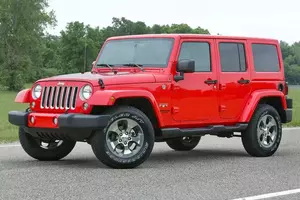
| Vehicle | Curb weight | Difference from world's smallest | Weight to power ratio | 0—60 mph acceleration ratio | Consumption ratio |
|---|---|---|---|---|---|
| 3.6 V6 Rubicon |
1862 kg / 4106 lbs |
1437 kg (3169 lbs) heavier | 7 kg to 1 hp | - | - |
| 2.2 Rubicon |
2207 kg / 4866 lbs |
1782 kg (3929 lbs) heavier | 11 kg to 1 hp | 225 kg/s (496 lbs/s) |
279 kg/L (615 lbs/L) |
| 2.2 Sahara |
2029 kg / 4474 lbs |
1604 kg (3537 lbs) heavier | 10 kg to 1 hp | 239 kg/s (527 lbs/s) |
274 kg/L (604 lbs/L) |
| 2.0 Sport |
1960 kg / 4322 lbs |
1535 kg (3385 lbs) heavier | 7 kg to 1 hp | - | - |
| 2.0 Rubicon |
2034 kg / 4485 lbs |
1609 kg (3548 lbs) heavier | 7 kg to 1 hp | - | - |
| 2.0 Sahara |
1987 kg / 4381 lbs |
1562 kg (3444 lbs) heavier | 7 kg to 1 hp | - | - |
| Vehicle | 3.6 V6 Rubicon |
|---|---|
| Curb weight |
1862 kg / 4106 lbs |
| Difference from world's smallest | 1437 kg (1437 lbs) heavier |
| Weight to power ratio | 7 kg to 1 hp |
| 0—60 mph acceleration ratio | - |
| Consumption ratio | - |
| Vehicle | 2.2 Rubicon |
| Curb weight |
2207 kg / 4866 lbs |
| Difference from world's smallest | 1782 kg (1782 lbs) heavier |
| Weight to power ratio | 11 kg to 1 hp |
| 0—60 mph acceleration ratio | 225 kg/s (496 lbs/s) |
| Consumption ratio |
279 kg/L (615 lbs/L) |
| Vehicle | 2.2 Sahara |
| Curb weight |
2029 kg / 4474 lbs |
| Difference from world's smallest | 1604 kg (1604 lbs) heavier |
| Weight to power ratio | 10 kg to 1 hp |
| 0—60 mph acceleration ratio | 239 kg/s (527 lbs/s) |
| Consumption ratio |
274 kg/L (604 lbs/L) |
| Vehicle | 2.0 Sport |
| Curb weight |
1960 kg / 4322 lbs |
| Difference from world's smallest | 1535 kg (1535 lbs) heavier |
| Weight to power ratio | 7 kg to 1 hp |
| 0—60 mph acceleration ratio | - |
| Consumption ratio | - |
| Vehicle | 2.0 Rubicon |
| Curb weight |
2034 kg / 4485 lbs |
| Difference from world's smallest | 1609 kg (1609 lbs) heavier |
| Weight to power ratio | 7 kg to 1 hp |
| 0—60 mph acceleration ratio | - |
| Consumption ratio | - |
| Vehicle | 2.0 Sahara |
| Curb weight |
1987 kg / 4381 lbs |
| Difference from world's smallest | 1562 kg (1562 lbs) heavier |
| Weight to power ratio | 7 kg to 1 hp |
| 0—60 mph acceleration ratio | - |
| Consumption ratio | - |
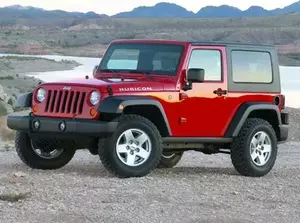
| Vehicle | Curb weight | Difference from world's smallest | Weight to power ratio | 0—60 mph acceleration ratio | Consumption ratio |
|---|---|---|---|---|---|
| 3.8i V6 Sport |
1755 kg / 3870 lbs |
1330 kg (2933 lbs) heavier | 9 kg to 1 hp | 193 kg/s (426 lbs/s) |
164 kg/L (362 lbs/L) |
| 3.8i V6 Sahara |
1792 kg / 3951 lbs |
1367 kg (3014 lbs) heavier | 9 kg to 1 hp | - |
137 kg/L (302 lbs/L) |
| 2.8 CRDi Sport |
1870 kg / 4123 lbs |
1445 kg (3186 lbs) heavier | 9 kg to 1 hp | 185 kg/s (408 lbs/s) |
263 kg/L (580 lbs/L) |
| 3.6i V6 12V Sahara |
1753 kg / 3865 lbs |
1328 kg (2928 lbs) heavier | 6 kg to 1 hp | 228 kg/s (503 lbs/s) |
155 kg/L (342 lbs/L) |
| 2.8 CRDi Sahara |
1858 kg / 4097 lbs |
1433 kg (3160 lbs) heavier | 9 kg to 1 hp | 184 kg/s (406 lbs/s) |
229 kg/L (505 lbs/L) |
| 3.8i V6 Rubicon |
1740 kg / 3837 lbs |
1315 kg (2900 lbs) heavier | 9 kg to 1 hp | 166 kg/s (366 lbs/s) |
150 kg/L (331 lbs/L) |
| Vehicle | 3.8i V6 Sport |
|---|---|
| Curb weight |
1755 kg / 3870 lbs |
| Difference from world's smallest | 1330 kg (1330 lbs) heavier |
| Weight to power ratio | 9 kg to 1 hp |
| 0—60 mph acceleration ratio | 193 kg/s (426 lbs/s) |
| Consumption ratio |
164 kg/L (362 lbs/L) |
| Vehicle | 3.8i V6 Sahara |
| Curb weight |
1792 kg / 3951 lbs |
| Difference from world's smallest | 1367 kg (1367 lbs) heavier |
| Weight to power ratio | 9 kg to 1 hp |
| 0—60 mph acceleration ratio | - |
| Consumption ratio |
137 kg/L (302 lbs/L) |
| Vehicle | 2.8 CRDi Sport |
| Curb weight |
1870 kg / 4123 lbs |
| Difference from world's smallest | 1445 kg (1445 lbs) heavier |
| Weight to power ratio | 9 kg to 1 hp |
| 0—60 mph acceleration ratio | 185 kg/s (408 lbs/s) |
| Consumption ratio |
263 kg/L (580 lbs/L) |
| Vehicle | 3.6i V6 12V Sahara |
| Curb weight |
1753 kg / 3865 lbs |
| Difference from world's smallest | 1328 kg (1328 lbs) heavier |
| Weight to power ratio | 6 kg to 1 hp |
| 0—60 mph acceleration ratio | 228 kg/s (503 lbs/s) |
| Consumption ratio |
155 kg/L (342 lbs/L) |
| Vehicle | 2.8 CRDi Sahara |
| Curb weight |
1858 kg / 4097 lbs |
| Difference from world's smallest | 1433 kg (1433 lbs) heavier |
| Weight to power ratio | 9 kg to 1 hp |
| 0—60 mph acceleration ratio | 184 kg/s (406 lbs/s) |
| Consumption ratio |
229 kg/L (505 lbs/L) |
| Vehicle | 3.8i V6 Rubicon |
| Curb weight |
1740 kg / 3837 lbs |
| Difference from world's smallest | 1315 kg (1315 lbs) heavier |
| Weight to power ratio | 9 kg to 1 hp |
| 0—60 mph acceleration ratio | 166 kg/s (366 lbs/s) |
| Consumption ratio |
150 kg/L (331 lbs/L) |
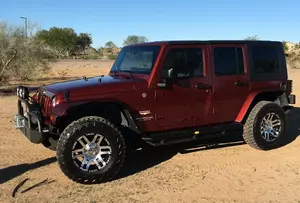
| Vehicle | Curb weight | Difference from world's smallest | Weight to power ratio | 0—60 mph acceleration ratio | Consumption ratio |
|---|---|---|---|---|---|
| 3.8i V6 12V Sahara |
1991 kg / 4390 lbs |
1566 kg (3453 lbs) heavier | 10 kg to 1 hp | - |
144 kg/L (318 lbs/L) |
| 3.6i V6 12V Sport |
1910 kg / 4212 lbs |
1485 kg (3275 lbs) heavier | 7 kg to 1 hp | 225 kg/s (496 lbs/s) |
163 kg/L (359 lbs/L) |
| 2.8 CRDi |
1980 kg / 4366 lbs |
1555 kg (3429 lbs) heavier | 11 kg to 1 hp | - |
200 kg/L (441 lbs/L) |
| 3.8i V6 12V |
1895 kg / 4178 lbs |
1470 kg (3241 lbs) heavier | 10 kg to 1 hp | - |
159 kg/L (351 lbs/L) |
| Vehicle | 3.8i V6 12V Sahara |
|---|---|
| Curb weight |
1991 kg / 4390 lbs |
| Difference from world's smallest | 1566 kg (1566 lbs) heavier |
| Weight to power ratio | 10 kg to 1 hp |
| 0—60 mph acceleration ratio | - |
| Consumption ratio |
144 kg/L (318 lbs/L) |
| Vehicle | 3.6i V6 12V Sport |
| Curb weight |
1910 kg / 4212 lbs |
| Difference from world's smallest | 1485 kg (1485 lbs) heavier |
| Weight to power ratio | 7 kg to 1 hp |
| 0—60 mph acceleration ratio | 225 kg/s (496 lbs/s) |
| Consumption ratio |
163 kg/L (359 lbs/L) |
| Vehicle | 2.8 CRDi |
| Curb weight |
1980 kg / 4366 lbs |
| Difference from world's smallest | 1555 kg (1555 lbs) heavier |
| Weight to power ratio | 11 kg to 1 hp |
| 0—60 mph acceleration ratio | - |
| Consumption ratio |
200 kg/L (441 lbs/L) |
| Vehicle | 3.8i V6 12V |
| Curb weight |
1895 kg / 4178 lbs |
| Difference from world's smallest | 1470 kg (1470 lbs) heavier |
| Weight to power ratio | 10 kg to 1 hp |
| 0—60 mph acceleration ratio | - |
| Consumption ratio |
159 kg/L (351 lbs/L) |
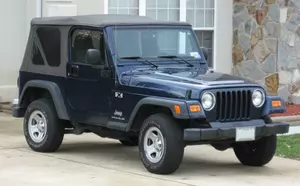
| Vehicle | Curb weight | Difference from world's smallest | Weight to power ratio | 0—60 mph acceleration ratio | Consumption ratio |
|---|---|---|---|---|---|
| 2.4 i 16V |
1605 kg / 3539 lbs |
1180 kg (2602 lbs) heavier | 11 kg to 1 hp | 129 kg/s (284 lbs/s) |
154 kg/L (340 lbs/L) |
| 4.0 i |
1495 kg / 3296 lbs |
1070 kg (2359 lbs) heavier | 8 kg to 1 hp | 174 kg/s (384 lbs/s) | - |
| 4.0 i Rubicon |
1725 kg / 3804 lbs |
1300 kg (2867 lbs) heavier | 9 kg to 1 hp | 194 kg/s (428 lbs/s) | - |
| 2.5 i |
1510 kg / 3330 lbs |
1085 kg (2393 lbs) heavier | 13 kg to 1 hp | 107 kg/s (236 lbs/s) | - |
| 2.5 i Soft Top |
1435 kg / 3164 lbs |
1010 kg (2227 lbs) heavier | 12 kg to 1 hp | 102 kg/s (225 lbs/s) | - |
| Vehicle | 2.4 i 16V |
|---|---|
| Curb weight |
1605 kg / 3539 lbs |
| Difference from world's smallest | 1180 kg (1180 lbs) heavier |
| Weight to power ratio | 11 kg to 1 hp |
| 0—60 mph acceleration ratio | 129 kg/s (284 lbs/s) |
| Consumption ratio |
154 kg/L (340 lbs/L) |
| Vehicle | 4.0 i |
| Curb weight |
1495 kg / 3296 lbs |
| Difference from world's smallest | 1070 kg (1070 lbs) heavier |
| Weight to power ratio | 8 kg to 1 hp |
| 0—60 mph acceleration ratio | 174 kg/s (384 lbs/s) |
| Consumption ratio | - |
| Vehicle | 4.0 i Rubicon |
| Curb weight |
1725 kg / 3804 lbs |
| Difference from world's smallest | 1300 kg (1300 lbs) heavier |
| Weight to power ratio | 9 kg to 1 hp |
| 0—60 mph acceleration ratio | 194 kg/s (428 lbs/s) |
| Consumption ratio | - |
| Vehicle | 2.5 i |
| Curb weight |
1510 kg / 3330 lbs |
| Difference from world's smallest | 1085 kg (1085 lbs) heavier |
| Weight to power ratio | 13 kg to 1 hp |
| 0—60 mph acceleration ratio | 107 kg/s (236 lbs/s) |
| Consumption ratio | - |
| Vehicle | 2.5 i Soft Top |
| Curb weight |
1435 kg / 3164 lbs |
| Difference from world's smallest | 1010 kg (1010 lbs) heavier |
| Weight to power ratio | 12 kg to 1 hp |
| 0—60 mph acceleration ratio | 102 kg/s (225 lbs/s) |
| Consumption ratio | - |
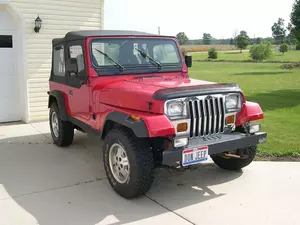
| Vehicle | Curb weight | Difference from world's smallest | Weight to power ratio | 0—60 mph acceleration ratio | Consumption ratio |
|---|---|---|---|---|---|
| 4.0 i |
1555 kg / 3429 lbs |
1130 kg (2492 lbs) heavier | 8 kg to 1 hp | 175 kg/s (386 lbs/s) |
104 kg/L (229 lbs/L) |
| 2.5 i |
1460 kg / 3219 lbs |
1035 kg (2282 lbs) heavier | 12 kg to 1 hp | 104 kg/s (229 lbs/s) |
107 kg/L (236 lbs/L) |
| Vehicle | 4.0 i |
|---|---|
| Curb weight |
1555 kg / 3429 lbs |
| Difference from world's smallest | 1130 kg (1130 lbs) heavier |
| Weight to power ratio | 8 kg to 1 hp |
| 0—60 mph acceleration ratio | 175 kg/s (386 lbs/s) |
| Consumption ratio |
104 kg/L (229 lbs/L) |
| Vehicle | 2.5 i |
| Curb weight |
1460 kg / 3219 lbs |
| Difference from world's smallest | 1035 kg (1035 lbs) heavier |
| Weight to power ratio | 12 kg to 1 hp |
| 0—60 mph acceleration ratio | 104 kg/s (229 lbs/s) |
| Consumption ratio |
107 kg/L (236 lbs/L) |